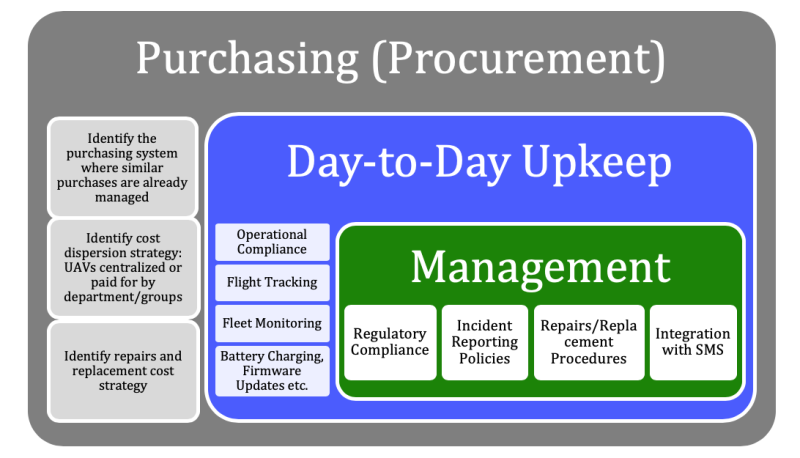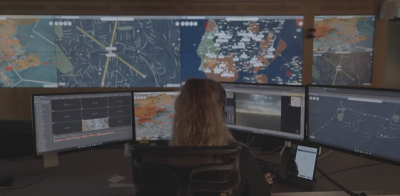Part 3 of Creating an Enterprise Drone Program: How to Avoid Communication Breakdowns and Time Wasted Between Enterprise Clients and DSPs
Once you’ve established who’s in charge of running your drone program, what happens next? This is where your DSPs need to integrate their product or service into your company’s existing workflows/structure. Your ability to show ROI or validate the program is vital. Due to the nature of an emerging tech industry, establishing your drone products or services into existing workflow structures is key to being able to measure, and then communicate, the impact of those drone enhancements.
The workflow integration process must be collaborative. For a sustainable UAS program, the technology stakeholder within the corporation needs to work closely with their drone service provider (DSP) to fold drone operations into existing company workflows. To do this effectively, there are five key points to be aware of when integrating drone enhancements into your existing workflows:
The most effective workflows are cross-functional
Technology stakeholders have limitations
Workflow efficacy impacts the DSP product/offering
DSPs can sometimes overextend themselves in order to fill gaps
Buy-in is crucial to effective workflow integration
Companies often have bidding processes and procedures, which can take time and put pressure on providers to lower prices to meet company policies. The person negotiating with the DSP may not have all the knowledge needed to make the best decisions up front. Drone programs perform more effectively when they are based on a cross-functional effort. Getting a DSP in front of the cross-functional team can save time and result in a more effective negotiation.
Engaging a cross-functional team requires collaboration across functional groups and departments. The value of a cross-functional approach to your UAS Program management can’t be overstated. Utilizing SMEs from across the organization minimizes blind spots and increases the sustainability of your processes and procedures. The objective of this group is to establish and maintain an awareness of all the different resources and data systems that are impacted by drone operations. Every organization is different, but examples of groups commonly included are Engineering, Human Resources, Legal, Finance, Regulatory, Safety, Operations, IT and Management. The UAS Program Manager (i.e. technology stakeholder) should be responsible for identifying and recruiting appropriate resources for the team. DSPs should be considered valuable resources during this process as well.
DSPs have a vested interest in the success of their clients’ drone programs. It is imperative to DSPs that a customer’s drone program be stable and long term in order to sustain the need for drone services. When drone programs fail, the DSPs’ sale is essentially discontinued.
From the technology stakeholder point of view, the success of the drone program is important because drones bring a lot of value to both day-to-day operations and long-term operational efficacy. When implemented correctly, UAS programs can save money, improve employee safety metrics, and increase employee engagement.
Integrating UAS operations into existing workflows is all about collaboration.
1. The Most Effective Workflows Are Cross-Functional
“There are two very important points here. One, is that some clients prefer to insert drone-based data into their existing workflow adding some incremental value without disturbing overall existing processes, systems or workflows. This is why it’s important for Firmatek to “speak the client’s language,” to understand their business, and provide meaningful insights rather than just the data. Drones can collect an overwhelming amount of data which many never get utilized by the client because they don’t have the means to analyze all of it.”
–Andrew Maximow, Chief Drone Officer, Firmatek
Drone programs perform more effectively when they are based on a cross-functional effort. In my professional opinion, companies should take the time up-front to think through all the workflows/departments that will be impacted by drone enhancements. Even in cases where strategic planning is not completed beforehand, the process is unavoidable, and it will happen organically at a later time. It’s inevitable and I highly recommend mapping out what you can before you begin to fly.
Mapping out all of the relevant workflows and systems will take considerably less time to complete if the technology stakeholder can pull together a cross-functional team within their organization to contribute to the effort. Your cross-functional strategy will offer greater insights into systemic needs and timeline expectations across the organization relevant to your drone operations. By engaging the company cross-functionally you will also raise awareness and engagement with the company’s blossoming drone program.
You’ll also need to know each and every system these groups rely on and the chain of command so that you know how much lag time is needed when making certain types of requests for your drone operations.
The cross-functional strategy should be broad in scope but targeted in activation. You want to be exhaustive in your efforts to identify workflows that could be affected by and/or integral to your drone operations. This will increase your ability to build a program that is solid, sustainable, and less likely to have its funding cut. Your goal is to make drone operations a portion of the company’s core operations.
Technology stakeholders would be best served by engaging a cross-functional team within their organization to ensure a comprehensive approach to integrating drone operations. The goals when approaching integration should always be safety, efficacy, and sustainability. Working collaboratively and getting your DSP in front of the cross-functional team could also improve the quality of decisions made.
To get started, technology stakeholders should identify the entire chain of command for all business units and their subsequent systems that are expected to be impacted by the UAS enhancements. Producing this comprehensive roadmap of workflows and systems ahead of time significantly reduces the need for reactive drone operations by enabling both the technology stakeholder and the DSP to anticipate workloads.
Some technology stakeholders are rooted in operations and others are appointed from within corporate groups that do not function in the field. It does not matter whether you are starting from within operations or within corporate departments as long as you think through the entire chain of command and document this. Begin with the functional area that you are most familiar with. Beginning with what you know will help build momentum as you map out the processes.
If you are a technology manager rooted in operations, your pathway may look something like this: Field operations, site supervisors, superintendents, regional managers, regional directors, corporate departments, and executive leadership. This process will allow you to identify areas where you lack knowledge on the systems, people and processes involved. Use this exercise to identify departments and system owners that need to be involved in the UAS program.
Once you have your team up and running, you’ll need to divvy up the workload. UAS Programs have work requirements that may overlap with other programs already in place at your company. For example, if your company has a fleet of cars, you’ll find that your UAS Program has similar needs such as requiring valid operator certifications, vehicle registrations, equipment procurement and vehicle maintenance schedules.
Here’s an example of what that functional breakdown may look like:
Program Management | • Creation of policies/procedures • Management of waivers/authorizations • Inventory management • Pilot management |
Operations Management | • Day-to-day flight management • Standard operating practices • Enforcing policies/procedures • Safety standards |
Legal/Compliance | • State and federal regulations • Constantly evolving laws (privacy, copyright, etc.) |
Human Resources | • Employee training and certification tracking • Employee status changes |
Information Technology | • Advanced UAS applications (3D modeling, analytics) • Systems integration/data security • Technical support |
2. Technology Stakeholders Have Limitations
“Breaking existing workflows may outweigh the benefits of drone-based data. Creating a new workflow may cause more pain than it’s worth. Another reason to maintain existing workflows is related to labor relations. People may feel their jobs are threatened by drone technology fearing their jobs may be eliminated or replaced. Being included in workflow integration efforts helps clients avoid these challenges.”
–Andrew Maximow, Chief Drone Officer, Firmatek
DSPs can be a resource during this process, but they are reliant upon the technology stakeholder for a majority of the information necessary to succeed.
DSPs should be aware that the technology stakeholder they are working with will have blind spots and limitations on how they can influence decision making within their company. All corporate employees have these types of limitations, regardless of whether they are based in operations or corporate functions. The most effective DSPs are aware of where these limitations are and remain mindful of when they’ve reached an insurmountable barrier as a result.
Generally speaking, established corporations are not looking to diversify their core business into the aviation arena, but rather view drones as a tool. Any industrial company can add value and increase safety and efficacy in their day-to-day operations with drones. Therefore, you can view your goal as building drone operations into the company’s existing corporate structure. Your cross-functional approach will enable you to build your program laterally and provide a stable foundation for growth.
Looking at the big picture, you’ll have operational employees, operational management, corporate functions, corporate functions management, and C-Suite executives. Your budget ultimately comes from the C-Suite level, but day-to-day operations are likely taking place on that operational employee level. C-Suites and operational levels don’t typically have a lot of direct interaction, that’s where the other aspects of your overall cross-functional strategy will come into play. Leaning on corporate functions will also be key. As the technology stakeholder, you’ll want to engage with the departments that handle legal matters, compliance management, certification tracking, training, and insurance matters.
Relying solely on yourself as the technology stakeholder put your efforts at risk of failing. Buying drone equipment and establishing a good working relationship with your DSP is not good enough. You must create buy-in across your organization. Having an open and honest dialogue between yourself and your DSP regarding the corporate structure of your organization will increase your chances for success.
3. Workflow Efficacy Impacts the DSP Product/Offering
“The other point of workflow integration is disrupting current inefficient ways of doing things identifying new value by redefining workflow and considering new types of analytics not possible before.”
–Andrew Maximow, Chief Drone Officer, Firmatek
Often times after a drone service provider begins to work with a company, they realize that their customer’s organization has other workflow issues that may make their services or products less effective, but they don’t have the power to address the issue. All they can do is make a recommendation, and often times you understand the recommendations being made and you may agree, but the power to create change is out of your hands. Addressing the identified issue would require involvement from a different department or other leadership area. This limits the degree to which your DSP’s product or service can succeed within your company.
You may find yourself utilizing multiple DSPs at other points in the workflow, and these may or may not integrate well together. This is not just challenging for the DSPs, but it can also create challenges for your organization. It can be difficult to get the greenlight for your drone program, and struggling to communicate to your internal resources how multiple DSPs differ from one another will only add to the confusion. This complicates communication efforts within the corporation and can act as a barrier during the cross-functional team building process. Creating buy-in on an emerging technology requires repetition and patience.
There is an educational portion to this process and having a clear concise message can go a long way. Sticking with one or two tried and true DSPs may make your efforts more successful.

Integrating drones into existing workflows is not as straight forward as other industries. To compare it to other tools, when a company needs to buy a certain number of computers, phones, office chairs, hammers, wrenches, PPE equipment, and so on, there is likely a set process in place for this. The company has likely set a policy or contract with a specific vendor and that company buys their respective equipment from said vendor. Everyone gets a company issued iPhone, for example, or peripherals like hand tools are available for purchase through the company procurement process. The same goes for resources. When a company needs X amount of concrete or X amount of lumber, everyone understands how to evaluate concrete or lumber, and a contract is already in place specifying which providers are approved by the company.
If you operate under the philosophy that drones are a tool, then the process should be just as standardized and straight forward for purchasing drones and drone peripherals (e.g., spare batteries, propellers, landing gear, etc.), and yet often times it isn’t. A fully active drone program may require different types of bidding contracts depending on what is outsourced and what is internal. Examples include flight services, data processing, data storage, software, hardware, payloads, training, and so on. You may try to morph one DSP into a one-stop-shop for all of your drone related needs or you may end up with a patchwork of DSP providers.
What can you do? From a DSP perspective, all you can do is the best with the information that you are given. Make your product or service as effective as possible within the circumstances that you are provided. Make recommendations where you can but be prepared to be lacking information and/or for your recommendations to go unheard.
Technology stakeholders should do what they can to gather all the relevant information and provide it to your DSP. This may mean working with other departments and forming a cross-functional team in order to find the right person(s) within your company to get you the holistic information that you and your DSP need to meet your goals. Having multiple DSPs doesn’t have to be a bad thing as long as you keep your messaging consistent. Keeping an open channel for information flow is going to decrease the risk of your drone program or drone efforts being shut down or losing funding.
4. DSPs Can Sometimes Overextend Themselves in Order to Fill Gaps
“Companies who have never used drones before rarely start with an integrated solution. They will still see the benefits of time and cost savings and reduction in hazardous man-hours when they start using drones. Then, the companies who want to maximize this value and institutionalize it across their company will integrate drones within existing operations. So, while companies can get more by including us in integration efforts, they can still see program success before they reach that stage.”
–David Bowen, VP, Measure
DSPs are also in a paradigm where they may need to offer more drone resources in order to help their target client establish or maintain a functional drone program. Yet, these efforts can divert time and resources away from their main product/service.
Specific to corporate drone programs, DSPs are typically pushed to do the actual flying for a company during both the sales cycle and during the early stages of the program’s development. Some companies have reported flying drones for a company for several months in order to showcase the value of their software/hardware or service. Some DSPs want to do the flying for companies, but even those who don’t usually end up doing some flying for their customers.
DSPs that offer things like advanced payloads, sensors, and data analytics products/services, for example, may be stuck continuing flight operations for their target client for 6 to 12 months after the initial demo while that company works to either identify a different outsourced flight option or establish flight operations internally. Depending on the drone service/product offered, the DSP is at risk of the client developing internal UAS operations and weaning off of the services or product being supplied.
Another area where DSPs typically extend themselves into is program documentation like standard operating practices, safety management systems and program policies. Many DSPs specialize in this and bring great value to companies, but not all DSPs are created equal. Some DSPs are rooted in technology and lack the business management experience required to truly add value to program management efforts. Others are based in aviation and lack the industry-specific business management experience that is vital to program management and standardization efforts. DSPs often find themselves in a position where these documents are required in order for their product or service to be successfully adopted by your organization.
Overextension of your DSP can negatively impact the quality of the service/product you initially purchased from your DSP. When this type of scope creep occurs, it is usually a symptom of an ineffective cross-functional strategy. Engaging the right people from across your organization is the best way to minimize scope creep.
5. Buy-in is crucial to effective workflow integration
“The value of drone data can be optimized when it is seamlessly integrated into a company’s existing workflows. This will lead to reduced downtime and increased revenue for our customer.”
–David Bowen, VP, Measure
Starting a new program of any kind takes work, but starting a new program rooted in an emerging (and growingly controversial) technology takes extra consideration. Efforts should be made to create buy-in across all levels of your organization.
Creating buy-in at the top (C-Suites) is vital to securing and maintaining funding for your corporate UAS program. Creating buy-in within the functional groups you’ve identified as key members of your cross-functional team is arguably more important because you rely on those resources to carry the workload. As the technology stakeholder, you need all the resources aligned with your new program to be engaged with the new work requirements being added to their existing responsibilities.
UAS Operators need to be engaged with the regulatory requirements associated with operating in the national airspace system. Having buy-in on the operator level can decrease the number of safety incidents and improve the overall quality of data collected, record keeping and vehicle maintenance.
Your functional corporate groups need to be excited about drones too. You want your cross-functional team to be actively engaged in problem solving at all times. UAS programs can evolve just as rapidly as FAA regulations and you’ll be best served by SMEs that are creatively solving problems and proactively identifying gaps in existing processes.
Ultimately your UAS Program is funded from above and for that reason you should be taking practical steps to create and maintain buy-in from the C-Suites. Executive leaders need to be fed information in succinct and tangible ways. Preparing a one-page summary with quantifiable metrics is always a good way to approach this.
Questions to be working through with your DSP at this stage include:
- Where does this drone product/service fit into the existing workflow of the company?
- Where should the decision-making power over this drone product/service reside within the existing management structure?
- Are there other processes/decision-making points that align with this drone product/service?
- How can we show the value of this effort to the C-Suite?
- What can my DSP provide to me in terms of reports or ROI numbers?
- How can my DSP and I work together to identify metrics that showcase the value their drone product/service is bringing to my company?
Questions to be asking as a DSP at this stage include:
- Who’s your contact in the company?
- Do you have different contacts within the company for different functions (e.g., operations, procurement, reporting, technical issues etc.)? If not, should you?
- How much decision-making power do my contacts have?
- Are there other decisions makers that need to be brought into the operations?
- How can you help your contact(s) establish the necessary structure to sustain their drone program (and thus your drone product/service)?
- How do you plan to show the value of your drone product/offering even after you’ve been hired, or your product has been purchased?
- Is there is a bidding process that you should be aware of? How often does it occur and what does it entail?
- In the event of a personnel change or departmental move, who will be your contact, and how far in advance would you be notified of any substantial changes to the department/group you currently work with?
Conclusion
In sum, UAS programs are more likely to succeed and will perform better if they are integrated into the existing corporate structure. The five key points to be aware of when integrating your UAS program are:
- The most effective workflows are cross-functional
- Technology stakeholders have limitations
- Workflow efficacy impacts the DSP product/offering
- DSPs can sometimes overextend themselves in order to fill gaps
- Buy-in is crucial to effective workflow integration
When done correctly, engaging a cross-functional team can address all five of these considerations. Collaboration can foster creative problem solving, disperse the workload, enable your DSP to focus on their service/product and create buy-in across your organization.
















Comments